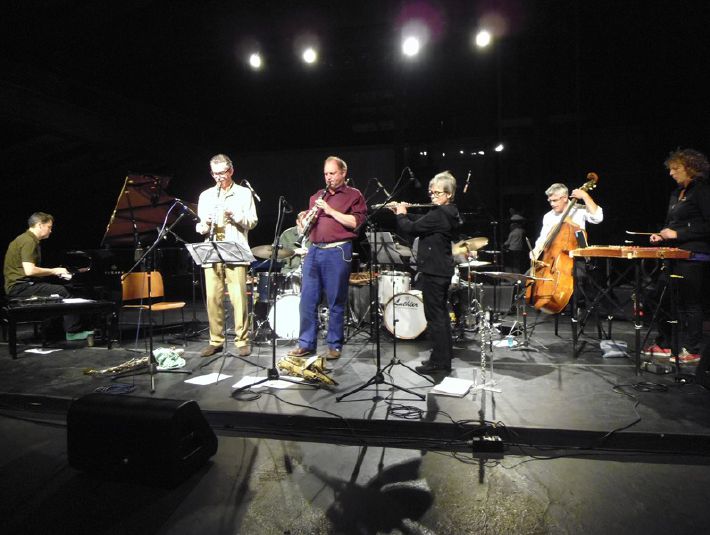Corkestra

Cor Fuhler – clavinet, organ/synthi, piano, compositions
Ab Baars – clarinet, tenor saxophone
Tobias Delius – tenor saxophone, clarinet
Nora Mulder – cimbalom
Michael Vatcher – percussion, singing saw
Tony Buck – percussion
Wilbert de Joode – double bass
Biography
Corkestra’s sound is vintage Cor Fuhler: tuneful, lively, colorful, humorous and a little bit off-center. That’s not to deny the contributions of the varied players involved: but Fuhler did bring them together, after all.
Their sound is distinctive as a fingerprint, what with that percussion section, 3 plucked and hammered string instruments, three winds but no brass, and the leader’s own puckish work on organ and clavinet spearheading the rhythm trio. Still, in some ways, Corkestra’s singular music does recall medium-size bands composer Sun Ra led over the years. His Arkestra was likewise driven by catchy, bumptious clavinet and bass licks; twittering flutes often crowned its open instrumental texture, when a powerful tenor sax might take the lead. And like Sun Ra, Fuhler has an ongoing fascination with antiquated electronic keyboards, like the Philicorda organ and the Synthi. It’s as if Cor had a keyboard handy for every mood, texture or coloristic palette his fellow players conjure up in their improvisations or treatments of themes.
Rather than provide the 2+3+4 nonet with full scores to interpret, he’s handed them something like a do-it-yourself composition kit. He’s written a collection of catchy riffs, bass vamps, and fast or slow, shorter or longer melody lines, which the players then assemble like building blocks, combining and superimposing them to create a new piece on the spot.
In the 1980s Anthony Braxton developed a way of layering one composition over another, but Fuhler’s complicated version sports its own inventive wrinkles. Sometimes a score specifies time values but not pitches, and sometimes the reverse. Sometimes the musicians are given a choice of two different versions of the same theme, or are allowed to skip notes here and there, and the multi-instrumentalists may select which axe to play it on. Players may pick their own tempo or key sometimes too, or may be allowed to play some notes sharp or flat, which makes for some curious parallel harmonies (as in Ornette Coleman’s harmolodics, or Monk’s clanking piano). And the musicians who aren’t following the score can embellish the composition in progress, or create a countermelody or some other feature.
That the same melodic fragments might recur in new guises in the course of a program allows for a level of thematic unity rare in improvised music. It’s fun for musicians, to get to flesh out a chart like that, and Fuhler’s puckish little tunes and tunelets are aimed at just such a sense of play. The absence of brass softens the ensemble sound from the git-go, and Delius’ s warm and furry tenor sax sound makes pretty lines even prettier. Not even the drummers trip each other up, for one thing because they listen to each other, and for another because each might play something else: Vatcher his tuned zither the hakkelbord, or his musical saw. The saw, which Vatcher plays with a violin bow, is a vital part of those pieces for which Fuhler does write (often open-ended) parts for specific players and instrumental voices, the aim being to recreate the pure sine waves of an early synthesizer using mostly acoustic axes.
It’s all part of the quest for a unique ensemble sound. Fuhler aids that search by turning the players loose in the improvised subgroups that punctuate a Corkestra set, letting the musicians discover the band’s own personality, and their own interrelationships, apart from the composer’s conscious intervention. In addition, textural group improvisations often lead the players to ideas they might not have anticipated, but which fit the needs of the moment. Granted, Fuhler does hint at which direction to sail in, by setting the order of pieces, making up the subgroups, and deciding which fragmentary pieces to combine. In devising modular set lists he takes cues from Misha Mengelberg’s ICP Orchestra, but even with ICP’s Ab Baars lending his extreme tenor sax and clarinet to the mix, this band goes its own way. Fuhler and his cohorts are too independent for anything else. Thinking for one’s self is a big part of what this Corkestra is about after all.
Reviews
“Sun Ra, Braxton, Mengelberg: in their different ways each is a genius at organizing organic, half-composed, half-improvised group music. Theirs are big footprints to walk in, but Cor Fuhler has big shoes of his own.”
Kevin Whitehead
“With dizzying variety, spectacular group interplay, and writing that astounds from start to finish, this one is a winner and has rocketed to the top of my recommended list.”
Michael Rosenstein *One Final Note: Jazz and Improvised Music Webzine


